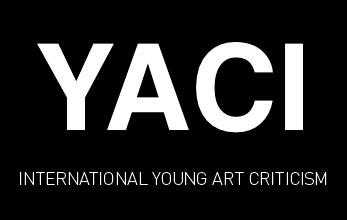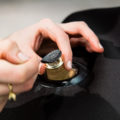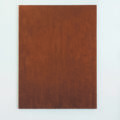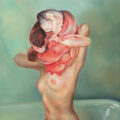MARION MOUNIC, FOR EVERYDAY LIFE POETRY
The room is plunged into darkness. A mixture of water and fluorescein excited by ultraviolet rays creates the only light source that gradually emerges from a thick ice cube that temperature and time liquefy. As the ground becomes rougher and as the hours pass, a body of water slowly invades the exhibition space. Fluorescent green, a colour created naturally by the chemical mixture in contact with black light, builds a hallucinatory landscape that plays on our senses and perception. This substance intrudes into the grooves of the tile and replays the invasion of a task that reduces the sharpness of a vision. We are as if projected into the middle of angiography, this medical examination of the fundus of the eye during which intravenous injected fluorescein spreads through the blood networks to the retina and makes it possible to grasp the progress of the stigmas left by the disease.
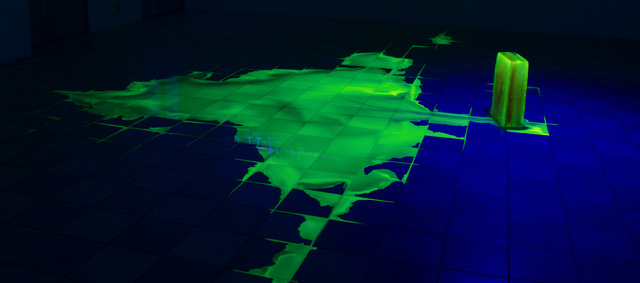
The maternal vision
Marion Mounic’s mother has Stargardt’s disease, an ocular syndrome characterized by the development of a stain on the retina that affects vision. “Is the grass as green for you as it is for me? How do you locate yourself in space? How different are our visions from each other? “asks the artist on a daily basis. Marion Mounic explores the abyss that separates an object from the vision we have of it, the gap that divides the experiences that everyone can have. If her mother’s descriptions are obviously unsatisfactory to fully appropriate her vision, they nevertheless allow the artist to better understand this gap. Today, she gives us her fantasized impressions through sensitive experiments that she increases with chemical constructions and the know-how of an engineer.
With Chroma, the experience is even more immersive. Marion Mounic interprets her mother’s night vision.
“While discussing with her, I understood that she was implementing a strategy in her travels by integrating the codes of illuminated signs. If she only sees a coloured cloud, she knows, for example, that only emergency signs, such as the pharmacy, can flash, or that tobacco takes its shape from the diamond, so she is located in the city. But what I found incredible was that when two neon lights of different colors are side by side their tints dissolve into each other.”
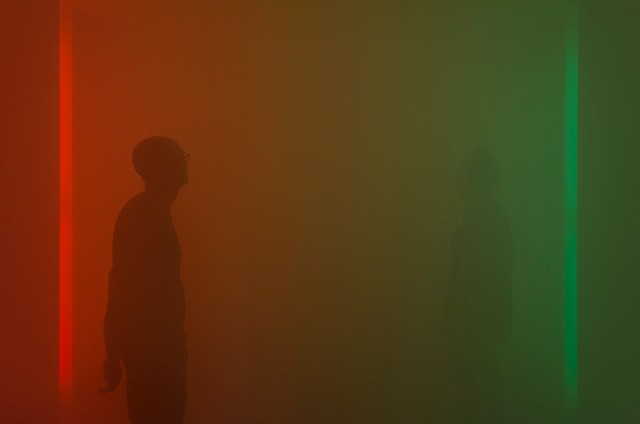
Excited by the idea of seeing a perfect gradation of chromatic variations, Marion Mounic creates a narrative of this altered vision. She places two neon lights opposite each other, whose rays, blurred by thick smoke, embrace each other, giving birth to a new hue and dissipating the bodies of the viewers who grope in this vaporous field.
“The world is ours. »
Then there is this residency that Marion Mounic is doing in 2016 in Morocco. There, more than vision, it is the gestures of everyday life that obsess him. Like this Tiznit terrace on which a multitude of blocks are, without apparent logic, placed on the ground. By questioning Mohamed El Mourid, the artist with whom she was staying, she learns that it is the fact of her father, who had since disappeared, who had multiplied his bases according to the advance of the Sun and the areas of shadows. Touched by this space of hospitality in rebus, Marion Mounic takes hold of this urgency to live, engine of creativity, and recreates this micro-territory that invites appropriation.

vue de l’exposition L’internationale, Haute école des arts du Rhin, Strasbourg, 2017.
This ingenuity of everyday life punctuates all of his Moroccan walks. In her second foster family, it is the permanent presence of women in their kitchens that challenges her. The constancy of these female movements that she quickly apparent to dance, the smoke that escapes from the pressure cookers, the fog that invades the windows obsess her… What are these household appliances? Symbols of an alienating loneliness that affects the Woman or emancipating forces? What is certain is that with these pressure cookers, the kitchen becomes a creative space where you compose your work by combining elementary and instinctive gestures. On her return from Morocco, Marion Mounic thus finds three pressure cookers that she puts on various engines, one from a blender, the others from faceted balls. Speeds vary silently depending on the machines, drawing an allegory of each cook conscientiously engaged in the task.

Whether she develops skilful chemical alloys or grabs the simplicity of readymade, explores the flaws of a vision or the repetition of daily activities, Marion Mounic leads us to appreciate these a priori insignificant details and forces her spectator to slow down and be moved by the poetry of everyday life.
Visuels : © Cyril Boixel
Image à la Une : Samâ’, cocottes-minute, moteurs, 2018
Site de l’artiste : www.marionmounic.com
